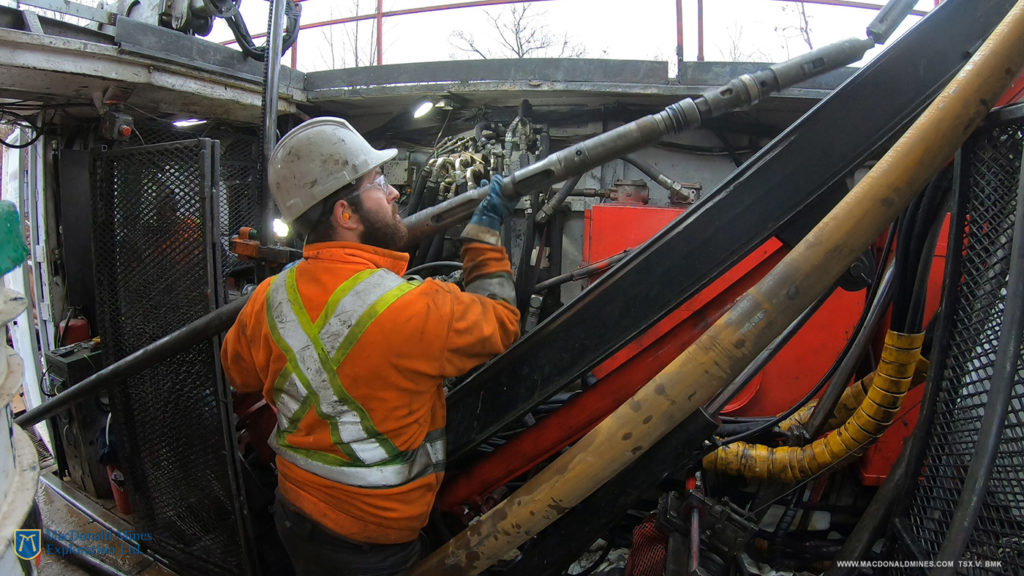MacDonald Mines drills 27.2 g/t gold over 5.13 metres, including 59.1 g/t over 1.87 metres at SPJ prospect

MacDonald Mines Exploration Ltd. [BMK-TSXV] reported the remaining assay results from its winter 2020 drilling program and results from three holes of its spring 2020 drilling program at the 100%-owned SPJ property, 20 km east of Sudbury, Ontario.
Hole 41 intersected 27.2 g/t gold over 5.13 metres in a new, near-surface discovery in the western extension of the New Zone-Villeneuve trend. Hole 43 intersected 2.3 g/t gold over 6.04 metres and 2.1 g/t gold over 3.08 metres in the New Zone-Villeneuve trend extending the zone of near-surface mineralization discovered in SM-19-022.
Mineralization in the New Zone-Villeneuve trend has been traced over more than 225 metres along strike and remains open along strike and to depth. These initial results from the spring program corroborate the recently completed IP (induced polarization) survey data used to target the drilling for this year’s program. Results for another four holes drilled this spring are pending.
Quentin Yarie, MacDonald’s President and CEOP, stated: “Our near-surface drilling continues to significantly extend the lateral footprint of mineralization at the Scadding deposit. These latest results show that thick, high-grade mineralization, located along the trend of the historic East-West pit, remains open. The development of a correlation of the IP data with the gold assays has proven a powerful tool. We have paused drilling as we await assays and conduct mapping and fieldwork to evaluate several new trends identified by the large 700 by 700-metre IP anomaly and the Jovan and Powerline prospects.”
Highlights include 27.2 g/t gold over 5.13 metres, including 59.1 g/t over 1.87 metres in hole SM-20-040. Hole SM-20-041 intersected three gold zones: 23.6 g/t gold over 0/97 metres, 34.4 g/t over 0.84 metres and 79.3 g/t over 1.03 metres. Hole SM-20-043 intersected 9.2 g/t gold over 0.87 metres and 3.0 g/t over 2.05 metres. Most intersections had visible gold.
MacDonald utilized its recent IP survey, combined with other data, to target its spring 2020 drill targets. The survey, conducted over an area of approximately 700 by 700 metres, shows a number of east-west trends that correlate with the historic pits and underground operations and illustrates the potential extent of mineralization around Scadding.
Holes SM-20-037 to -039 were drilled to test the down-dip and lateral continuity of the zone of chlorite alteration in the Bristol/Monaco structure in the North pit area. The holes successfully intersected chlorite alteration in the projected extensions of the structure, including visible gold in SM-20-038. The successful intersection of chlorite alteration in all the holes shows that the mineralized structures remain open laterally and at depth, and that additional drilling could uncover new zones of gold mineralization.
Hole SM-20-040 was testing the down-plunge extension of the mineralization intersected in SM-19-012, in the extension of the structure that hosts the Scadding underground mine. The hole intersected an unexpected diabase dike where the chlorite zones were expected.
Hole SM-20-041 was testing the hinge area of a fold in the New zone-Villeneuve trend, 80 metres west of the western end of the East-West pit where trenching identified chlorite alteration in folded sedimentary rocks. Results from SM-20-041 indicate that the hinge area is well mineralized.
Holes SM-20-043 successfully intersected the down-plunge extension of the high-grade mineralization discovered in the New zone-Villeneuve trend in SM-19-022, in the eastern extension of the East-West pit. It was collared in chlorite alteration that was never previously recognized and visible gold was observed in one location in the chlorite zone in association with later quartz veining. SM-20-043 indicates that the gold-mineralized iron alteration zone extends down-dip and down plunge of the intersection in SM-19-022.
The SPJ property hosts the high-grade past producing Scadding gold mine. Evidence of polymetallic mineralization at the Scadding deposit are indicative of IOCG (iron-oxide-copper-gold) potential. There are significant gold, cobalt, copper, silver, nickel and rare earth showings outside of the Scadding deposit footprint.
Historically, the Scadding Mine produced 914 kilograms of gold from 127,000 tonnes of mineralized material grading 7.2 g/t (OFR 5771). MacDonald’s reinterpretation of the geological model at the Scadding deposit and larger SPJ property indicates that it could host a gold-rich iron-oxide-copper-gold deposit and that significant gold structures may have been missed by previous operators’ drilling campaigns (2009 to 2011).
